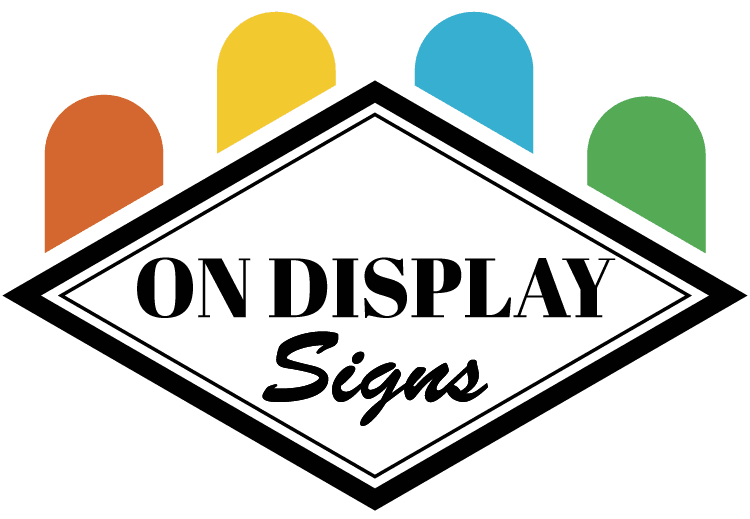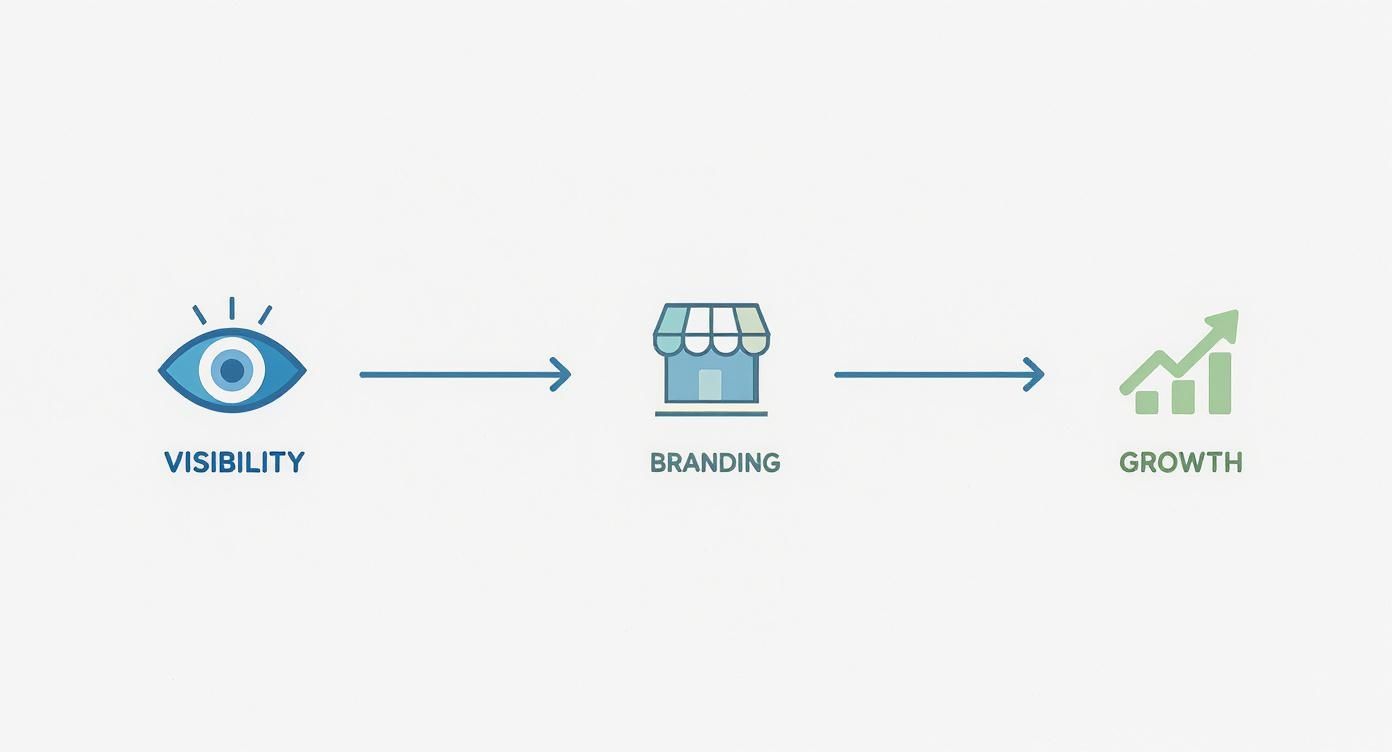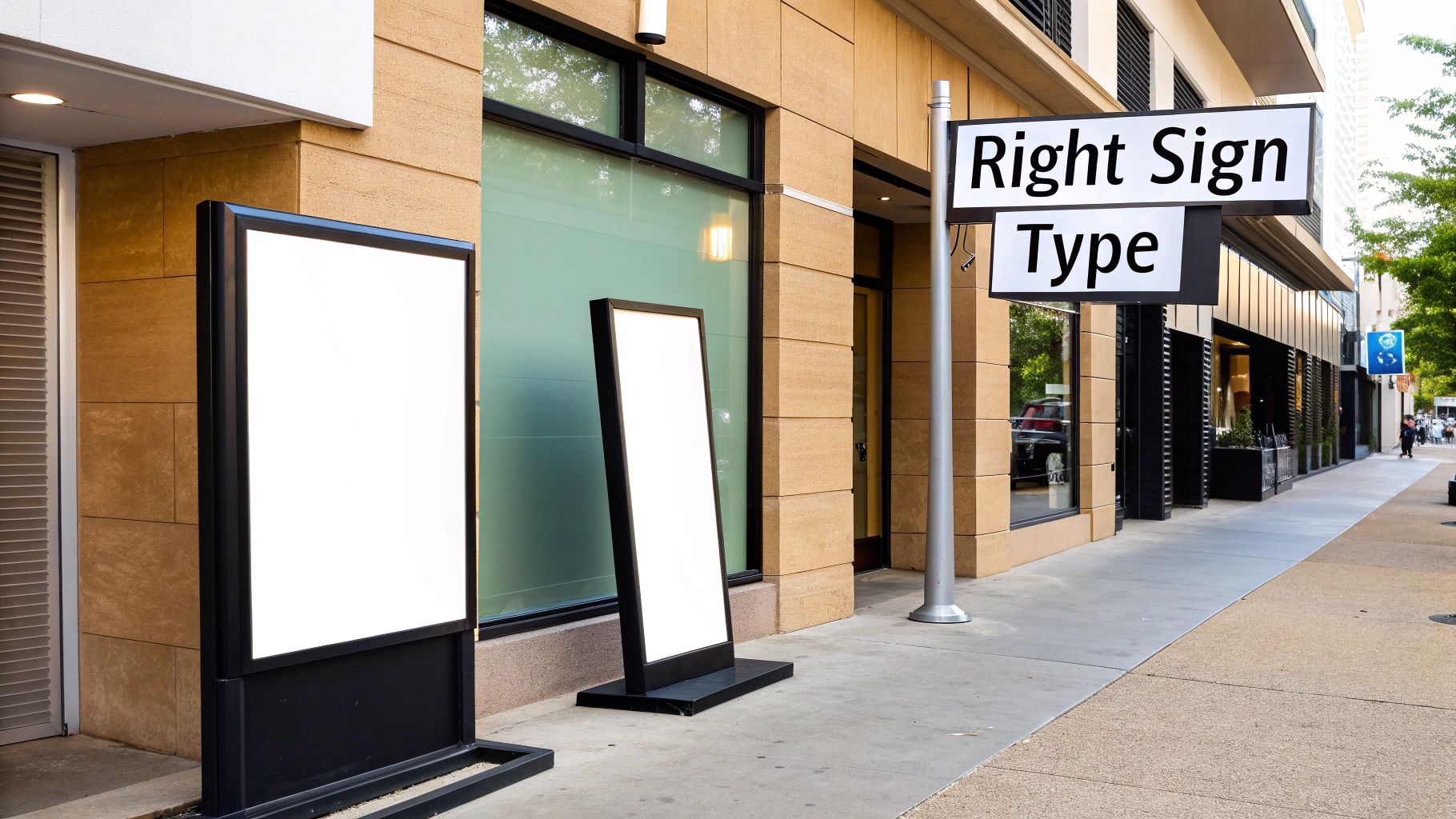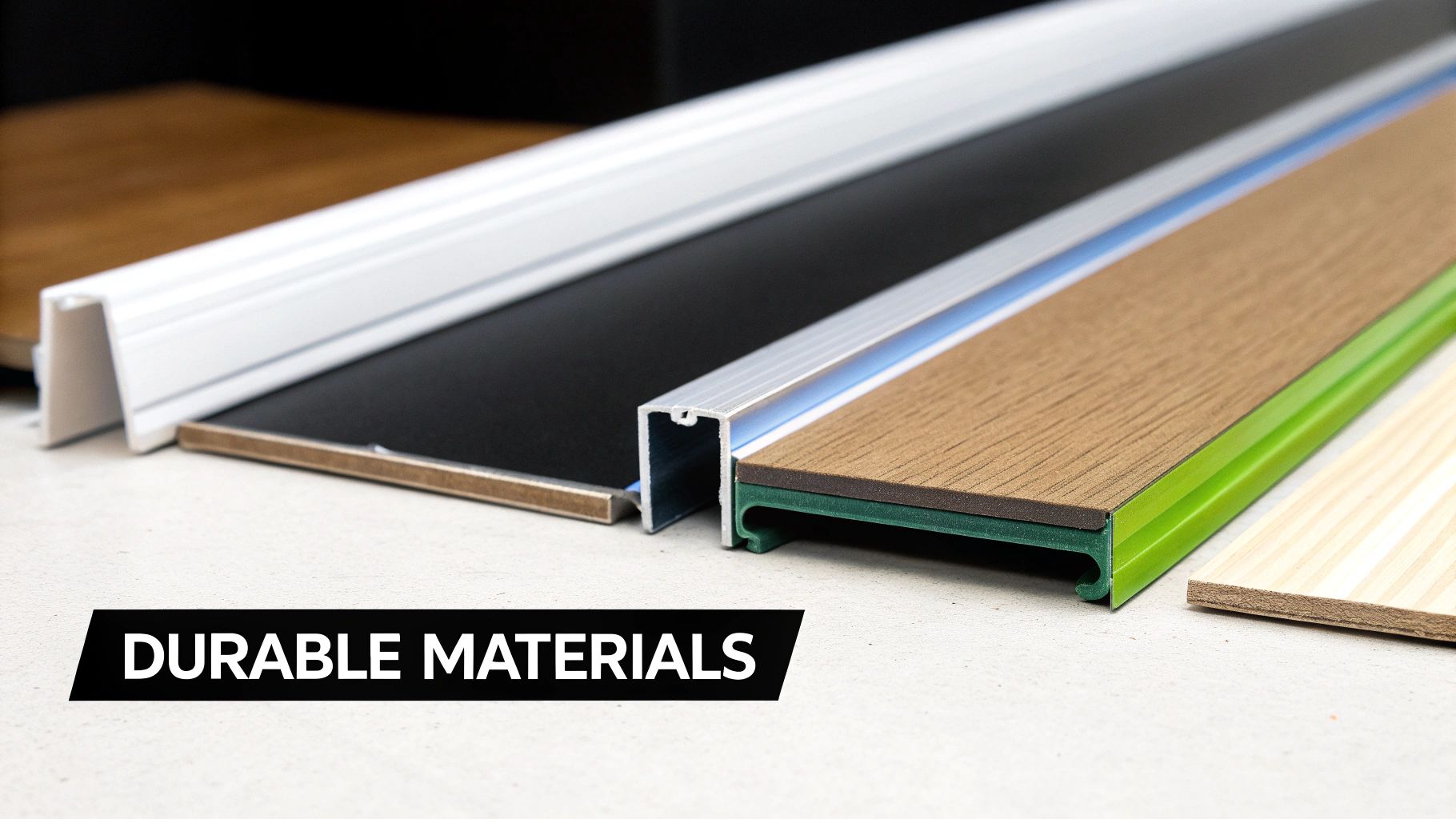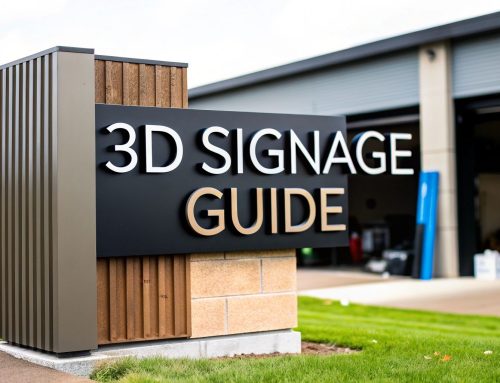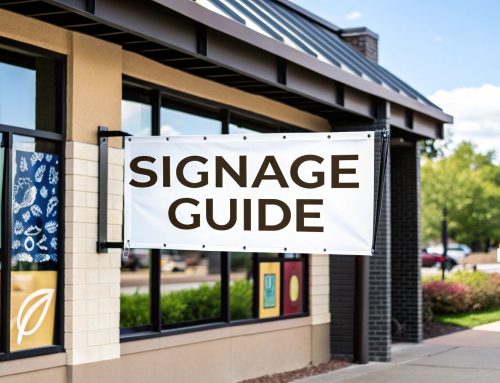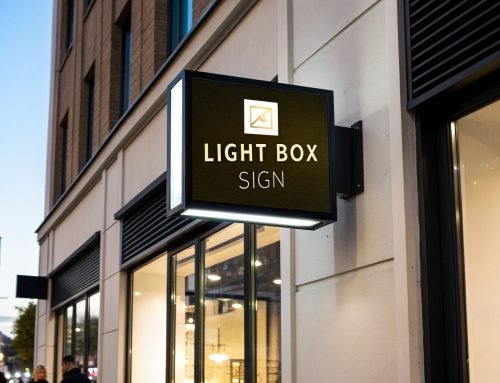Think of your outdoor lighted box sign as your most hardworking employee. It’s the silent salesperson that never calls in sick, working 24/7 to grab attention and pull customers through your door. For any business with a physical storefront, it’s one of the single best investments you can make, turning your location into a beacon that’s impossible to miss.
Why Your Business Needs an Outdoor Lighted Box Sign
In a crowded market, just being there isn't enough—you have to be seen. An outdoor lighted box sign does way more than just put your name on the building. It’s a constant, low-effort form of advertising that builds brand recognition and drives foot traffic, directly boosting your bottom line.
Picture someone driving down your street after dark. All the unlit storefronts fade into the background, but a crisp, glowing sign cuts right through the noise. That constant visibility makes you a landmark in your community, easy to find and hard to forget. For example, a local diner with a bright, welcoming sign becomes the default meeting spot, while a dark storefront next door is easily overlooked.
Maximize Your Visibility and Brand Recognition
The whole point of a sign is to get noticed. An illuminated sign takes that job to a whole new level, making your brand pop from a distance, day or night. This round-the-clock presence helps cement your business in the minds of people who pass by every day, turning them from casual observers into future customers.
An actionable insight here is to consider your sign's visibility from key traffic arteries. Drive the main roads near your business at night. Can you spot your location easily? If not, an illuminated sign is a clear solution. When someone nearby needs exactly what you offer, your well-lit, professional sign ensures you’re the first name that comes to mind.
Project a Professional and Trustworthy Image
A professionally made, well-kept lighted sign sends a clear message before a customer ever speaks to you. It says you're established, you're credible, and you care about quality. On the flip side, a burnt-out or shabby-looking sign can suggest your business is struggling or just doesn't care.
An illuminated sign is a beacon of trust. It signals that your business is open, active, and ready to serve, creating a welcoming impression that encourages people to step inside.
That first impression is everything. It sets the stage for the entire customer experience. For instance, a medical clinic with a clean, brightly lit sign appears more professional and trustworthy than one with a dim, flickering light. Good signage for commercial buildings is a fundamental part of creating an inviting and professional environment. It's a direct investment in your brand's reputation that pays off in customer confidence for years to come.
Understanding How Your Lighted Box Sign Works
An outdoor lighted box sign might look like a single piece, but its magic comes from three core components working in perfect harmony. Think of it as a well-built machine: every part has a job, ensuring your sign is bright, tough, and professional-looking.
At its heart, every box sign is built from a cabinet, a face, and an illumination system. Getting these three elements right is the key to creating a sign that grabs attention and can stand up to the elements for years.
The Anatomy of a Lighted Box Sign
First, you have the cabinet—the tough outer shell that holds everything together. This is the sign's structural backbone, usually built from extruded aluminum. Why aluminum? Because it's incredibly strong for its weight and naturally resists rust and corrosion, keeping the sensitive electrical parts inside safe from rain, wind, and whatever else the weather throws at it.
Next up is the sign face, which is basically your brand's canvas. This is the translucent panel where your logo and message shine through. Modern signs almost always use durable plastics like acrylic or polycarbonate because they diffuse light beautifully and are tough enough to handle outdoor life.
Finally, the illumination system brings it all to life. These days, that means Light Emitting Diodes (LEDs). The industry has moved almost entirely to LEDs for good reason: they are incredibly energy-efficient, last for ages (often over 50,000 hours), and produce a bright, even glow. This is the technology that powers modern outdoor advertising, as this infographic shows.
As you can see, great lighting isn't just about being seen—it's about strengthening your brand and driving real business growth.
Why Quality Components Matter
To get a clearer picture of how these parts come together, let's break them down.
Key Components of a Lighted Box Sign
| Component | Common Materials | Primary Function |
|---|---|---|
| Cabinet | Extruded Aluminum, Steel | Provides the structural frame and protects internal components. |
| Sign Face | Acrylic, Polycarbonate, Flex-Face Vinyl | Displays graphics and allows light to pass through. |
| Illumination System | LEDs, Fluorescent Tubes (older signs) | Lights up the sign face for nighttime visibility. |
Each of these choices has a direct impact on how long your sign will last and how good it will look.
The global outdoor LED lighting market was valued at an incredible USD 33.99 billion in 2024 and is expected to hit USD 136.57 billion by 2034. That explosive growth is happening because businesses know that quality LEDs save money and perform better.
Choosing quality materials isn't about extravagance; it's about longevity. A well-built sign with a sturdy aluminum cabinet, a crack-resistant polycarbonate face, and efficient LEDs will save you significant money on repairs and replacements down the road.
For a practical example, if your business is in an area known for hailstorms or high winds, springing for a polycarbonate face instead of standard acrylic is a no-brainer. It might cost a bit more upfront, but its powerful impact resistance means you won't be paying for a new sign face after the first big storm. When you're thinking about lighting, you might also want to understand the technology behind a digital sign with LEDs. Making smart choices on these components from the start ensures your sign works for you, day in and day out.
Choosing the Right Sign Type for Your Location
Picking the perfect outdoor lighted box sign isn't just about what it says—it's about where you put it. The right sign has to match your specific location and your business goals. It’s all about making sure your message connects with the right audience, whether they're flying past at 40 mph or just strolling down the sidewalk.
A sign that works wonders for a warehouse next to the highway would be totally wrong for a small boutique in a historic downtown. Knowing the main types of lighted box signs is the first step toward making a smart investment in your visibility and making your physical location work harder for you.
Wall-Mounted Signs The Classic Choice
The most common and flexible option you'll see is the wall-mounted lighted box sign. These are installed flat against your building’s facade, giving you fantastic visibility to anyone approaching your storefront head-on. They're the go-to for retail stores, restaurants, and offices in strip malls or standalone buildings where direct visibility is king.
A practical example is a dental office in a suburban shopping center. A wall-mounted sign is the perfect tool to clearly identify its location to patients pulling into the parking lot. These signs are straightforward, effective, and a staple for a reason—they get the job done.
Projecting Blade Signs for Pedestrian Traffic
If your business is on a busy pedestrian street or a dense urban block, a flat wall-mounted sign can easily get lost. This is where projecting signs, often called "blade signs," really shine. These signs are mounted perpendicular to the building, sticking out over the sidewalk to grab attention.
A projecting sign acts like a flag, catching the eye of foot traffic moving in either direction along the street. This makes them ideal for cafes, bars, and small shops where capturing the attention of passersby is crucial for drawing in impulse customers.
For example, a historic bookstore on a main street would use a classic, ornate blade sign to stand out among a row of flat signs, beckoning pedestrians to come inside. They break up the flat plane of a building's facade with a classic, eye-catching look, making your business pop in a crowded row of storefronts.
Freestanding Monument and Pylon Signs
For businesses set back from the road or tucked inside a large office park, a sign on the building itself just won't be visible enough. Freestanding monument signs are low-profile, permanent structures built right at the entrance of a property. They give off a feeling of permanence and professionalism, making them perfect for corporate campuses, medical facilities, and upscale communities.
On the other hand, pylon signs are those tall, pole-mounted signs you see towering over highways and major commercial roads. Their height gives them unbeatable long-distance visibility, making them essential for gas stations, hotels, and fast-food restaurants that need to attract drivers from a long way off. As you figure out your plan, it’s helpful to explore all the different types of outdoor business signs out there to make the best choice.
Selecting Materials for Durability and Visual Impact
The materials you pick for your outdoor lighted box sign are the backbone of its performance and longevity. Think of it like building a house—if you skimp on the foundation, you’re just setting yourself up for expensive problems down the road.
Investing in quality, durable materials from day one ensures your sign can handle whatever the weather throws at it and continues to look professional for years. The two most important parts to get right are the sign face itself and the cabinet that holds everything together.
Choosing the Right Sign Face
The face of your sign is where your brand lives. It needs to be tough enough to resist fading, weather, and impacts while letting the light inside shine through evenly for a crisp, bright look. The two heavy hitters in this category are acrylic and polycarbonate.
- Acrylic: This is the go-to choice for many businesses. It’s budget-friendly and offers fantastic optical clarity with a glossy finish that makes colors pop.
- Polycarbonate: While it comes with a higher price tag, polycarbonate is in a different league when it comes to strength. It’s far more impact-resistant, making it the clear winner for signs in high-risk areas or places with severe weather like hail storms.
To make the choice a little easier, here's a quick comparison of the two most common materials used for lighted sign faces.
Material Comparison for Sign Faces
| Feature | Acrylic | Polycarbonate |
|---|---|---|
| Impact Resistance | Good | Excellent |
| Clarity & Finish | Excellent, glossy finish | Very good, but can be less glossy |
| Cost | More affordable | Higher upfront cost |
| Weather Resistance | Good, but can become brittle over time | Excellent, handles temperature extremes well |
| Best For | General use, low-traffic areas | High-traffic areas, harsh climates |
An actionable insight: if your business is near a baseball field, a golf course, or a busy road where debris can be kicked up, polycarbonate is a practical necessity. It offers peace of mind, protecting your sign from damage that could easily crack or shatter a standard acrylic face.
Building a Resilient Cabinet
The sign cabinet is the armor that protects the internal lighting and wiring. For this job, extruded aluminum is the undisputed industry standard, and for good reason. It’s lightweight yet incredibly strong, and it won't rust or corrode.
While you might see other metals used, aluminum gives you the perfect mix of strength and weather resistance without being overly heavy. For an even tougher build, you can look into materials like aluminum composite panels, which offer rock-solid durability with a clean, modern aesthetic. Dig deeper into the benefits of aluminium composite signage to see if it’s the right call for your project.
The demand for durable, dynamic signs is a big reason why the outdoor LED display market is booming—it's projected to hit USD 23.4 billion by 2030. This trend just underscores how critical it is to choose materials that can stand the test of time and support modern technology.
Designing a Sign That Gets Noticed Day and Night
A great sign is so much more than a box with lights inside; it's a strategic piece of visual communication. An effective design for an outdoor lighted box sign has to work just as hard at high noon as it does at midnight, grabbing the attention of potential customers around the clock.
This all comes down to a few core principles that are simple on the surface but absolutely essential in practice. It’s about creating graphics that are legible, impossible to ignore, and a true reflection of your brand.
Prioritize Clarity with High-Contrast Colors
When a sign is lit from behind, colors can do funny things. A design that looks perfect on a computer screen can quickly turn into a blurry, unreadable blob when it's backlit. The secret to avoiding that is one simple word: high contrast.
You need to think in terms of light versus dark. Bold, dark text on a bright background (think black on white or deep blue on yellow) is a classic for a reason—it’s incredibly easy to read. On the flip side, light text on a dark background (like white on black) pops beautifully and stands out sharply against the night sky.
An actionable tip: print your proposed design in black and white. If the text and logo are still perfectly clear and easy to read, you have a strong high-contrast design. Avoid low-contrast combinations like yellow on white or gray on black, as the light will cause them to bleed into each other.
Your sign is competing with countless other visual distractions. A high-contrast design cuts through all that noise, making your message instantly clear to someone driving by in just a few seconds.
Getting the color scheme right is your first major step toward a sign that actually works.
Choose Fonts Built for Readability
Fancy, intricate fonts might look artistic up close, but from a distance, they become a mess. For outdoor lighted box signs, your best friends are fonts that are bold, simple, and clean.
- Go Bold: Stick with thick, substantial letterforms. Thin, delicate fonts lose all their definition when lit up and can look washed out or even broken.
- Keep it Simple: There's a reason pros stick with sans-serif fonts like Helvetica, Futura, or Arial. Their clean lines and consistent thickness make them exceptionally easy to read from far away.
- Give it Space: You have to ensure there's enough space—what designers call kerning—between each letter. If the text is too crowded, it just becomes a jumbled block of light at night.
The massive shift toward dynamic digital signage is proof of how critical clear visuals are. The outdoor LED display market was already valued at about USD 7.87 billion in 2023 and is only growing. You can read more about the trends in outdoor LED signage to get a feel for this explosion. This trend just hammers home the point: designs must be clean and clear, whether they're on a static sign or a digital screen.
Navigating Installation Permits and Maintenance
Once your new outdoor lighted box sign is ready, you're on the home stretch. But getting it installed and planning for its upkeep are just as critical as the design itself. This is where you protect your investment and make sure your sign works safely and looks great for years to come.
When it comes to installation, this is not a DIY project. An improperly mounted sign is a massive safety hazard, and the electrical work demands a certified pro. It’s absolutely essential to understand the electrical contractor license requirements in your area to ensure the person you hire is qualified, insured, and doing the job by the book.
Securing Permits and Following Regulations
Before a single bolt is turned, you have to deal with local permits and zoning laws. Just about every city and county has its own rulebook for signs—dictating size, height, placement, and even brightness. Trying to skip this step can get you hit with hefty fines or, even worse, an order to tear your brand-new sign down.
Tackling the permit process early prevents costly delays and ensures your sign complies with all local ordinances from day one. A professional sign company can manage this entire process for you.
This is where having an experienced sign partner really pays off. They know the local codes inside and out and can handle the mountain of paperwork for you, making the whole process surprisingly smooth. If you want to get a better sense of what's involved, you can learn more about sign permit requirements and see why it’s a job best left to the experts.
A Simple Maintenance Checklist
A little bit of upkeep goes a long way. It keeps your sign looking sharp and stops small problems from snowballing into expensive repairs. Think of it as basic care to ensure your sign remains a bright, welcoming beacon for your business.
Follow this simple checklist to keep your sign in top condition:
- Routine Cleaning: At least twice a year, give the sign face a gentle cleaning. All it takes is a soft cloth, some mild soap, and water to wipe away the dirt and grime that can make it look dim. A practical example would be cleaning it in the spring after the winter weather passes and again in the fall before the holiday season.
- Visual Inspections: Get in the habit of glancing up at your sign. Look for any cracks in the face, peeling graphics, or lights that are starting to flicker. Catching these things early saves a lot of headaches.
- Check for Pests: Birds and insects love to build nests in warm, sheltered spots. Make sure they haven't made a home inside your sign, as they can cause serious damage to the wiring.
- Annual Professional Check-Up: Once a year, have a sign technician give it a proper inspection. They’ll check the electrical components and structural integrity to make sure everything is safe and sound for the year ahead.
Common Questions About Outdoor Lighted Box Signs
When you’re thinking about investing in a major marketing tool like an outdoor lighted box sign, of course you're going to have questions. Getting honest, straightforward answers is the key to making a smart decision that will serve your business well for years to come.
Here are a few of the most common questions we hear from business owners just like you.
How Long Do These Signs Last?
A well-made lighted box sign is built for the long haul. The actual structure, which we call the cabinet, is usually constructed from tough, weather-resistant extruded aluminum. With just a little basic care, it can easily last a decade or even longer.
The lighting technology has come a long way, too. The high-quality LEDs we use today are incredibly reliable and are often rated for 50,000+ hours of continuous use. That means your sign can stay bright for years before you ever have to think about electrical maintenance, giving you a fantastic return on your investment.
What Is the Average Cost of a Lighted Box Sign?
This is a tough one to answer because every lighted box sign is a completely custom job. The final price tag really comes down to a few key choices that affect the materials and the amount of work involved.
- Size and Complexity: It makes sense that a big, double-sided sign will cost more than a small, simple one.
- Materials: Choosing a premium, impact-resistant polycarbonate face instead of a standard acrylic will adjust the price.
- Design: A simple text-based sign is different from one with complex, multi-colored graphics.
- Installation: The height of the sign and how easy it is to access the installation spot will also play a role in the final quote.
A small, basic sign might start in the low thousands, but larger or more intricate signs can be a bigger investment. The only way to know for sure is to get a detailed quote based on exactly what you need.
Try not to think of your sign's cost as just another business expense. See it as an investment in 24/7 advertising that pays for itself by bringing in more eyes and more customers.
Do I Need a Permit for My Sign?
In almost every single case, the answer is a firm yes. Your city or town has specific zoning rules and building codes that control the size, location, and even the type of business signs they allow. These rules exist to keep the public safe and make sure the community looks good.
Trying to put up a sign without the right permits is a recipe for disaster—you could face hefty fines and even be ordered to take it down. A professional sign company will handle the entire permitting headache for you, making sure your new sign is 100% compliant with local laws.
Ready to make your business shine? The team at On Display Signs, Inc. manages every step of the process, from design and permitting to professional installation. Get your custom sign quote today
